Concrete sidewalks and walkways significantly enhance Florida properties, offering durability, low maintenance, and safety. These pathways withstand harsh climate conditions while providing design versatility through custom styles, colors, and textures. Weather-resistant features like heat-resistant mixtures, water-repellent treatments, and UV protection coatings ensure longevity. Well-designed concrete paths improve curb appeal, boost property value, and ensure accessibility. Regular maintenance, including inspections and seasonal upkeep, extends their lifespan. The installation process involves site preparation, form setup, and proper curing. When considering costs, factors such as area size, design complexity, and material selection play crucial roles. Exploring these aspects further reveals the full potential of concrete pathways for Florida properties.
Benefits of Concrete Pathways
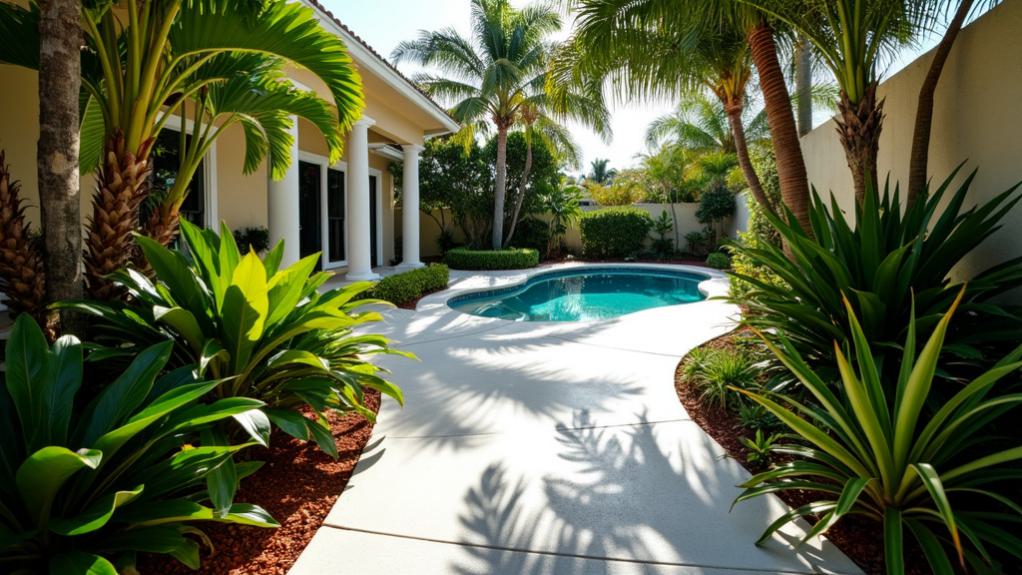
Why choose concrete for your pathways? Concrete offers numerous advantages for Florida property owners seeking durable, low-maintenance, and visually appealing walkways. Its versatility allows for both aesthetic appeal and functional design, making it an ideal choice for various outdoor applications.
Concrete pathways provide exceptional durability, withstanding Florida's harsh climate, including intense sunlight, heavy rainfall, and occasional freezing temperatures. This resilience translates to a longer lifespan compared to alternative materials, reducing long-term maintenance costs.
Additionally, concrete's smooth, even surface enhances safety by minimizing trip hazards and providing stable footing for pedestrians of all ages.
From a design perspective, concrete offers unlimited possibilities. It can be colored, stamped, or textured to complement your property's architecture and landscaping. The material's adaptability allows for seamless integration with existing features, creating a cohesive outdoor environment.
Furthermore, concrete's thermal properties help regulate surface temperatures, making it comfortable to walk on even during hot Florida summers.
Lastly, concrete pathways contribute to improved property value and curb appeal, making them a wise investment for homeowners and businesses alike.
Design Options and Styles
Versatility in design is a hallmark of concrete pathways, offering property owners a wide array of options to suit their aesthetic preferences and functional needs. Concrete can be molded into various shapes and patterns, allowing for custom designs that complement the existing landscape or architecture. From straight, linear paths to winding, organic forms, the possibilities are extensive.
Modern aesthetics can be achieved through sleek, minimalist designs with clean lines and smooth surfaces. Alternatively, decorative finishes can add texture and visual interest. Stamped concrete replicates the look of natural materials like stone, brick, or wood, while exposed aggregate finishes reveal the beauty of embedded pebbles or stones.
Color options are virtually limitless, with integral pigments, stains, and dyes available to create vibrant hues or subtle earth tones.
Concrete pathways can also incorporate functional elements such as built-in lighting, drainage systems, or slip-resistant surfaces. Borders, edging, and inlays provide opportunities for further customization.
Weather-Resistant Features
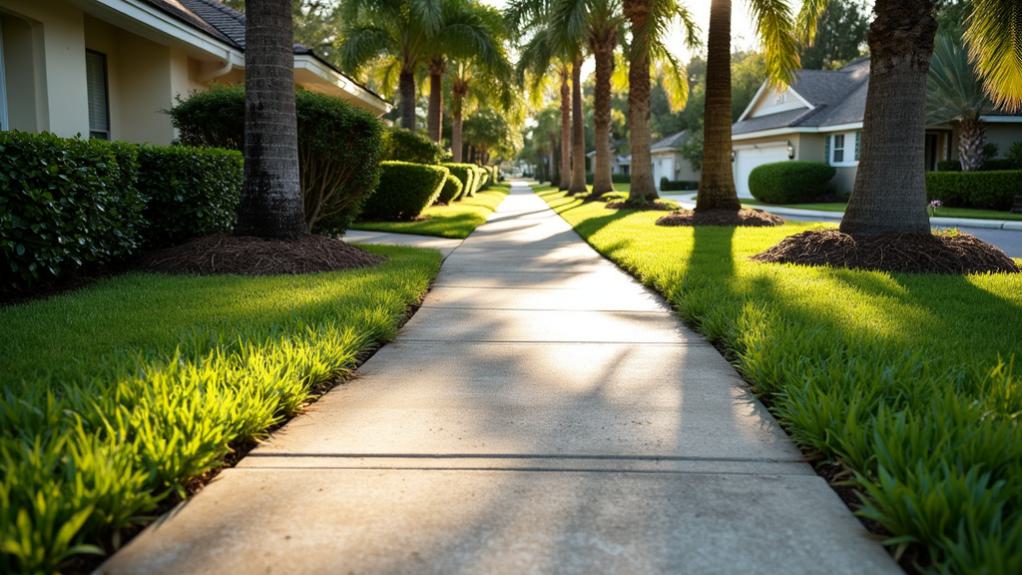
Weather-resistant features are essential for ensuring the longevity and durability of concrete sidewalks and walkways.
Heat-resistant concrete mixtures can mitigate thermal expansion and cracking in extreme temperatures, while water-repellent surface treatments provide protection against moisture infiltration and freeze-thaw damage.
UV protection coatings offer an additional layer of defense, preventing sun-induced degradation and maintaining the aesthetic appeal of the concrete surface over time.
Heat-Resistant Concrete Mixtures
Increasingly, heat-resistant concrete mixtures are becoming essential for sidewalks and walkways in areas prone to extreme temperatures. These advanced formulations incorporate specialized additives and materials that enhance the concrete's ability to withstand high temperatures and reduce heat absorption. By utilizing heat-resistant mixtures, property owners can significantly improve the longevity and comfort of their outdoor surfaces.
Key benefits of heat-resistant concrete mixtures include:
- Reduced surface temperature
- Improved thermal insulation properties
- Enhanced durability in extreme weather conditions
- Decreased risk of thermal cracking and expansion
When selecting a heat-resistant concrete mixture, consider factors such as local climate, expected foot traffic, and desired aesthetics. Some mixtures incorporate reflective aggregates or light-colored pigments to further reduce heat absorption. Additionally, eco-friendly options are available that utilize recycled materials or low-carbon cement alternatives.
To maximize the effectiveness of heat-resistant concrete, proper installation techniques are crucial. This includes ensuring adequate curing time, applying appropriate sealants, and incorporating expansion joints to accommodate thermal movement.
Regular maintenance, such as cleaning and resealing, will help preserve the heat-resistant properties and extend the lifespan of the concrete surface.
Water-Repellent Surface Treatments
While heat resistance is a valuable property for concrete sidewalks and walkways, protection against water infiltration is equally important for maintaining structural integrity.
Water-repellent surface treatments offer an effective solution to enhance the longevity and performance of concrete surfaces in Florida's humid climate. These treatments typically involve the application of waterproof sealants, which create a protective barrier against moisture penetration.
Silane and siloxane-based sealants are commonly used for their ability to penetrate the concrete surface, forming a hydrophobic layer that repels water while allowing the material to breathe. This characteristic is crucial for preventing trapped moisture, which can lead to deterioration and spalling.
Additionally, fluoropolymer-based sealants provide excellent surface durability and resistance to UV radiation, making them suitable for exposed outdoor applications.
When applying water-repellent treatments, proper surface preparation is essential. The concrete must be clean, dry, and free of contaminants to ensure optimal adhesion and penetration of the sealant.
Regular reapplication, typically every 3-5 years, is necessary to maintain the protective properties and extend the lifespan of the concrete sidewalks and walkways.
UV Protection Coatings
Protecting concrete sidewalks and walkways from the damaging effects of ultraviolet (UV) radiation is crucial for maintaining their structural integrity and aesthetic appeal.
UV protection coatings provide an effective barrier against the sun's harmful rays, preventing premature deterioration and discoloration of concrete surfaces. These specialized coatings offer numerous UV protection benefits, including enhanced durability, color retention, and reduced maintenance costs.
When applying UV protection coatings, proper application techniques are essential for optimal performance. The process typically involves:
- Thorough surface preparation, including cleaning and repairs
- Application of a primer to enhance adhesion
- Even distribution of the UV-resistant coating using rollers or sprayers
- Allowing adequate curing time before exposing the surface to foot traffic
UV protection coatings are available in various formulations, including acrylic-based and polyurethane-based products.
These coatings form a transparent, protective layer that shields the concrete from UV radiation while maintaining its natural appearance. Some advanced formulations also incorporate additional features such as slip resistance and water repellency, further enhancing the overall performance and longevity of concrete sidewalks and walkways in Florida's challenging climate.
Enhancing Curb Appeal
Concrete sidewalks and walkways play a crucial role in enhancing a property's curb appeal. These functional elements can be transformed into aesthetically pleasing features that complement the overall design of a home or business.
By carefully considering landscaping integration, property owners can create a seamless transition between hardscapes and softscapes. Incorporating plants, shrubs, or decorative grasses along the edges of walkways can soften the appearance of concrete and add visual interest.
Color schemes are another important aspect of enhancing curb appeal through concrete surfaces. Stained or tinted concrete can be used to match or complement the exterior color palette of the building.
Stamped patterns or textured finishes can mimic the look of more expensive materials like brick or natural stone, adding a touch of elegance to the property. Additionally, well-designed lighting along walkways not only improves safety but also highlights the beauty of the concrete surfaces and surrounding landscaping during evening hours.
Improving Property Value
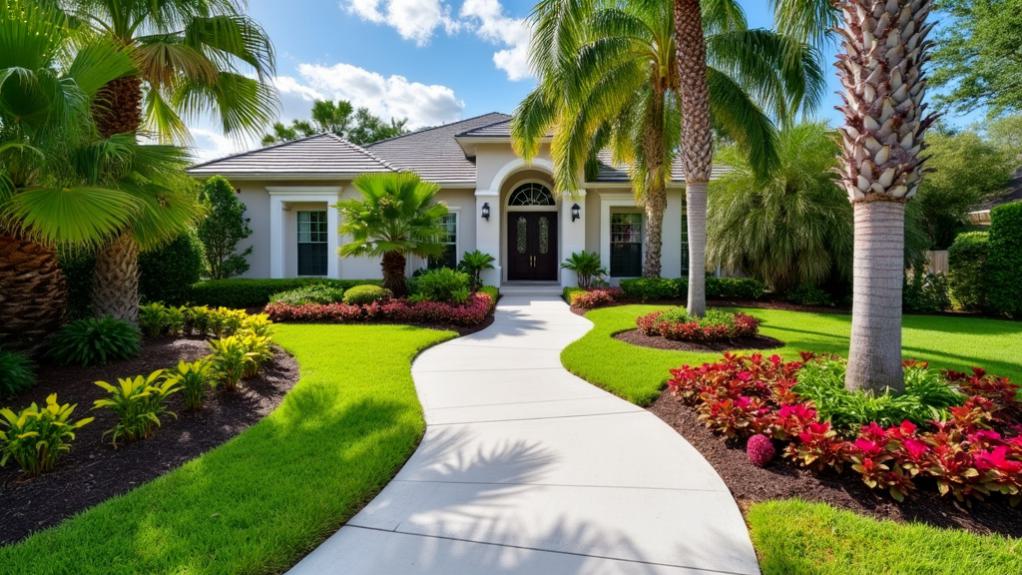
Concrete sidewalks and walkways significantly contribute to a property's value through their impact on curb appeal and resale potential.
Well-designed and properly maintained concrete paths create an inviting entrance and enhance the overall aesthetics of a property, instantly boosting its curb appeal.
This improved visual appeal, combined with the functional benefits of durable concrete walkways, can increase a property's marketability and potentially lead to a higher resale value.
Curb Appeal Boost
When considering home improvements that can significantly enhance property value, well-maintained concrete sidewalks and walkways often top the list. These functional hardscape elements play a crucial role in boosting a property's curb appeal, creating an inviting first impression for potential buyers or visitors.
Concrete pathways, when strategically designed and installed, can seamlessly integrate with existing landscaping enhancements, elevating the overall aesthetic appeal of the property.
To maximize the curb appeal boost provided by concrete sidewalks and walkways, consider the following:
- Incorporate decorative stamping or texturing techniques
- Utilize contrasting border colors or materials for visual interest
- Implement curved designs to soften straight lines and add character
- Install outdoor lighting along pathways for safety and ambiance
Well-executed concrete walkways not only improve the visual appeal of a property but also provide practical benefits. They create defined paths for foot traffic, reducing wear on lawns and gardens.
Additionally, properly sloped and drained concrete surfaces prevent water accumulation, mitigating potential foundation issues and enhancing the overall functionality of the outdoor space.
Increased Resale Potential
Enhancing a property's resale value, well-constructed concrete sidewalks and walkways contribute significantly to a home's overall marketability. These features not only improve functionality but also create a positive first impression for potential buyers.
In Florida's competitive real estate market, properties with well-maintained exterior elements tend to command higher prices and sell more quickly.
Recent resale trends indicate that homes with defined concrete pathways often outperform those without in terms of both sale price and time on market. This is partly due to the perceived value of a property that appears well-cared for and structurally sound.
Concrete sidewalks and walkways, when properly installed and maintained, can last for decades, signaling to buyers that the property has been consistently updated and improved.
Market demand for properties with enhanced outdoor spaces has increased, particularly in Florida's climate where outdoor living is emphasized year-round.
Concrete walkways facilitate easy navigation around the property, connecting various outdoor areas and creating a cohesive exterior design. This integration of functional and aesthetic elements aligns with current buyer preferences, potentially increasing a property's resale value by several percentage points.
Safety and Accessibility Considerations
Ensuring the safety and accessibility of concrete sidewalks and walkways is paramount for public infrastructure. Proper design and construction must adhere to accessibility standards, incorporating features that accommodate users of all abilities. Slip resistance is a critical factor in preventing accidents, especially in areas prone to wet conditions. Textured surfaces or specialized coatings can significantly enhance traction, reducing the risk of slips and falls.
When considering safety and accessibility, key factors include:
- Adequate width for wheelchair users and pedestrians
- Smooth transitions between surfaces to prevent tripping hazards
- Proper slope and cross-slope for drainage and ease of use
- Installation of tactile warning strips at curb ramps and crossing points
Regular maintenance and inspections are essential to identify and address potential hazards promptly. Cracks, uneven surfaces, and vegetation overgrowth can pose significant risks to users.
Implementing a comprehensive maintenance plan ensures longevity and continued safety of the infrastructure. Additionally, proper lighting along walkways enhances visibility during low-light conditions, further improving safety for all users.
Maintenance and Longevity
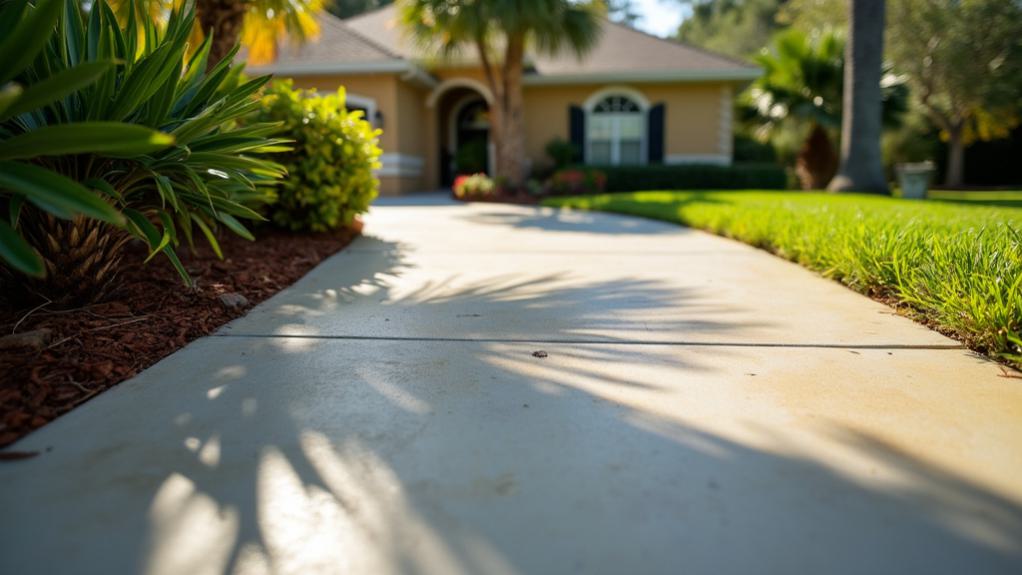
Proper maintenance is the cornerstone of long-lasting concrete sidewalks and walkways. Regular inspections and timely interventions can significantly extend the lifespan of these structures, ensuring their functionality and aesthetic appeal for years to come.
Implementing a comprehensive maintenance plan involves both routine cleaning and targeted repair techniques.
Seasonal upkeep is crucial in Florida's climate. During the rainy season, ensure proper drainage to prevent water pooling, which can lead to erosion and surface degradation. In drier months, address any cracks or chips promptly to prevent further deterioration.
Utilize appropriate repair techniques such as patching, resurfacing, or joint sealing, depending on the extent of damage.
Periodic pressure washing removes accumulated dirt, mold, and stains, preserving the concrete's appearance and preventing slip hazards.
Apply a quality concrete sealer every 2-3 years to protect against moisture intrusion and chemical damage. For older sidewalks, consider decorative overlays or stamping to rejuvenate their appearance while reinforcing their structural integrity.
Installation Process
When undertaking the installation of concrete sidewalks and walkways, a systematic approach is essential for achieving durable and aesthetically pleasing results. The process begins with thorough site preparation, including excavation, grading, and compaction of the subgrade. Proper drainage must be ensured to prevent water accumulation and subsequent damage to the concrete surface.
The installation process typically involves the following steps:
- Form setup and reinforcement placement
- Concrete mixing and pouring
- Screeding and floating the surface
- Finishing and curing
Preparation techniques play a crucial role in the longevity of the sidewalk or walkway. These include soil stabilization, installation of a gravel base, and the use of vapor barriers when necessary.
Essential installation tools include concrete mixers, vibrators, screeds, floats, and trowels. Each tool serves a specific purpose in achieving the desired surface texture and structural integrity.
Careful attention to detail during the installation process is paramount. Factors such as concrete mix design, reinforcement placement, and proper curing techniques significantly impact the final product's quality and durability.
Cost Considerations
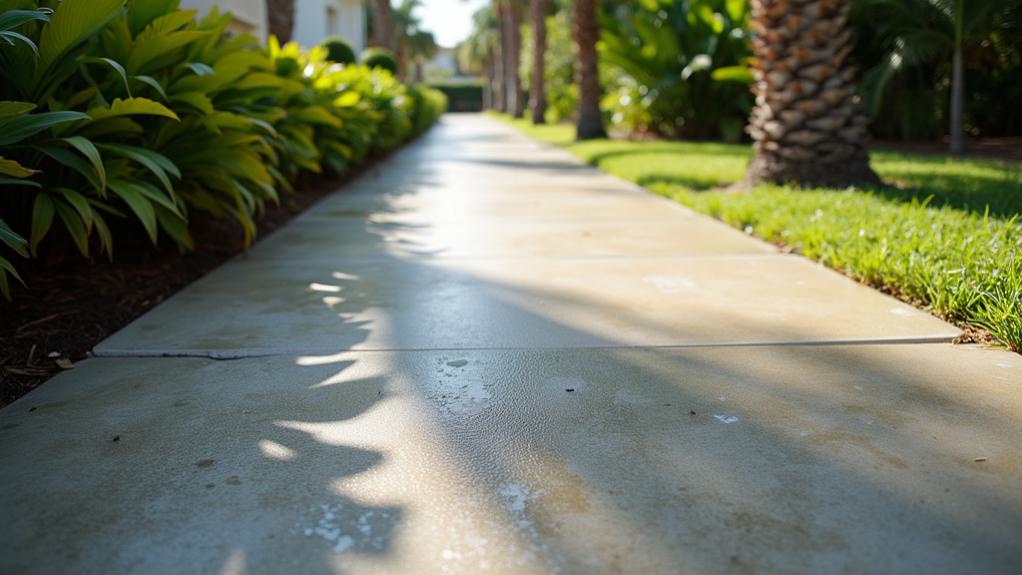
Several factors influence the cost of concrete sidewalks and walkways, making accurate estimation crucial for project planning and budgeting. The primary cost determinants include the size of the area, complexity of design, site preparation requirements, and material choices.
Larger projects typically benefit from economies of scale, reducing per-square-foot costs. However, intricate patterns or curves can increase labor expenses.
Site conditions significantly impact costs. Uneven terrain, poor soil quality, or the need for extensive grading may necessitate additional preparation work.
Material selection also plays a vital role in budget planning. While standard concrete is cost-effective, decorative options like stamped or colored concrete can substantially increase expenses. Additionally, reinforcement materials, such as wire mesh or rebar, contribute to overall costs but enhance durability.
Labor costs vary by region and project complexity. Urban areas often have higher rates than rural locations.
Permits and inspections add to the total expense and should be factored into the budget. Considering long-term maintenance costs is crucial for comprehensive financial planning.
While initial installation costs are important, investing in quality materials and workmanship can reduce future repair expenses and extend the lifespan of the concrete sidewalk or walkway.
Conclusion
Concrete sidewalks and walkways offer numerous benefits for Florida properties, combining durability, aesthetics, and functionality. These structures enhance curb appeal, improve property value, and provide safe, accessible pathways. With various design options, weather-resistant features, and low maintenance requirements, concrete pathways are a practical investment. Proper installation and cost considerations are crucial factors. By carefully planning and implementing concrete walkways, property owners can significantly enhance their outdoor spaces while ensuring long-term value and functionality.
